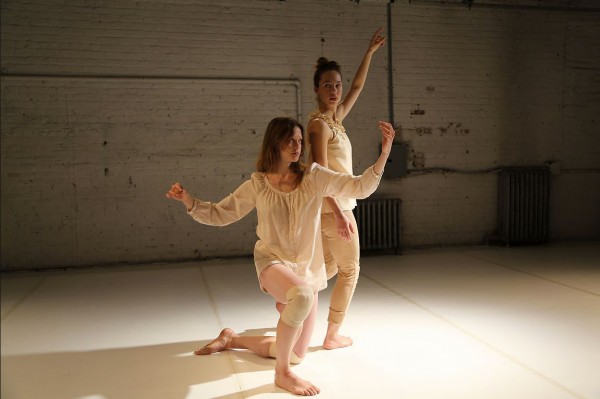
photo by Madeline Best. courtesy of Chocolate Factory Theater.
Is looking the only way to be? What a cryptic way to begin.
Two women smile at each other with wit and admiration as if one were the other’s muse coming into mortality.
A montage of facial expressions feels like a palindrome at the point of turning in on itself.
A robot points to a subtle arrangement on the ceiling.
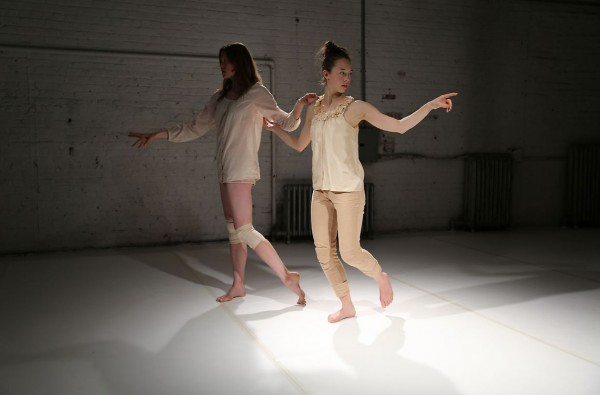
photo by Madeline Best. courtesy of Chocolate Factory Theater.
Fingers bloom while playing a string instrument that is actually a face. More fingers hold a jaw lightly, a face frame, the beginning of another situation.
To be in the body and feel each pose reaching and swelling. This is another way to say that women are sprawling, exploratory beings.
This is another way to say two ghosts are growing and shrinking as a means of waiting and coming apart.
A full wheel reminds me of the discomfort of being upside down, reminding me of a scene from Ingmar Bergman’s The Silence.
To crabwalk is to make the body look like a contorted insect or the spirit of an old marionette.

photo by Madeline Best. courtesy of Chocolate Factory Theater.
What does it feel like to have an elbow attached to a string and then pulled away from the heart?
A stutter is the forearm collapsing into the floor. This does not ruin the form, but alters it; similar to the way a handwritten signature can alter a blank piece of paper.
Almost speaking is the moment before speech occurs. The body settles inside of it, a luminous oval.
The thought is going forward and backwards. It is about to form.
As it forms it rises from the earth.
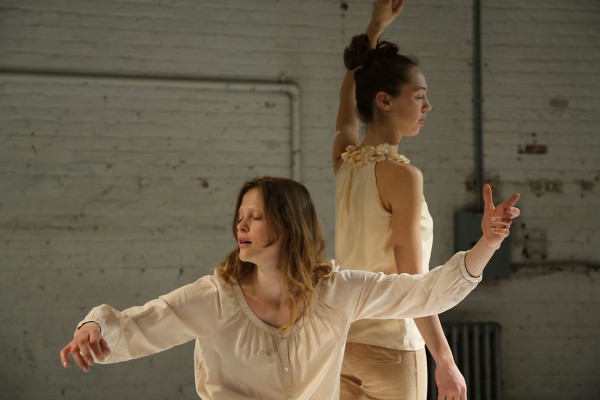
photo by Madeline Best. courtesy of Chocolate Factory Theater.
Two women being and smiling at each other should not be confused with a secret, but the realization that to be is not the same as to want.
Ursula Eagly’s SELF MADE MAN MAN MADE LAND premiered at The Chocolate Factory on March 27, 2013. SELF MADE MAN MAN MADE LAND, a response is a poem that addresses the inexplicable and gravitational force of Eagly’s performance. These words seek to unfold, expand, and challenge what Brian Seibert of The New York Times refers to as “improvisational filler” and “precious little content” in his review published on March 31, 2013. A response is also a psychic exploration of my experience inside the work, particularly Eagly’s languorous contortions, which Seibert compared to as ‘come-ons.’ ]]>

installation shot of Rosemarie Trockel: A Cosmos, 2012-13. photo by Benoit Pailley. courtesy of New Museum.
The natural order legitimizes itself but never without consequence, shrine, or wool.
Seeds disperse wildly into the air, transgressing their predetermined narrative.
The flower regarded as sin, its origins devoured by science.
An orangutan declares its supremacy in the animal kingdom then goes on to shape our perception of painting and otherness.
A singular experience confined to the role of watcher, mother.
Coincidentally, the name of this piece is called Landscapian Shroud of My Mother.
The absence of a crowd and subtle elevation in space makes the piece clear and breathable, even though it feels like it’s mourning.
A fly rests on a baby’s cheek. A cosmos bleeds into a microscope.
The irrational need for classification belittles us, causing restlessness and doubt. There is not much struggle to change the order of things.
Some are classified as more ‘wild’ than others. I misread the label as savage.
How to accurately read the lines of a crab, or the soft undulations of a jellyfish?
The question stays with me until a large battery resting on a pillow interrupts it.
Once a stereotype is set free in the world, a secret stairway reveals itself.
Funny how wool makes itself into Chinese paper, how breath guides us into foreign space.
Wool is dry and unforgiving when stretched over canvas. I find this fact troublesome. This one is called Black Cab 2.
The arrival of ‘outsiders’ raises questions about juxtaposition as a form of colonization.
In the case of a cosmos, marginalized individuals take on the quality of hallucinations. There but not there. There but only in the context of the Artist.
Here a grater is enlarged to the size of a baby elephant. Its violence is confrontational yet decent when mounted in the same room as a sofa.
My focus deviates from the walls to the significance of time and measurement when imagining the universe (not to be confused with the universal). The shift is slow, long and ornate, mirroring the wingspan of a bird.
Birds in cages, not even alive, become subtle extensions of reality.
Domestic textures become foreign, alien. I love the way they are reduced to feeling.
As if feeling is all there is when addressing kindred spirits.
Rosemarie Trockel: A Cosmos is on view through January 20, 2013 at New Museum, 235 Bowery, New York.
]]>—–
A loud dripping sound echoes in the background.
A single leg shoots up amidst a heap of black tarp and rubble.
It feels like an abandoned sewer, or a secret hideout turned crime scene.
Most of Miriam occurs in the dark, under Clausse’s dramatic lighting direction. One must lean in to see. One must rely on other senses to fully experience.
—–

The leg flexes its foot and starts to come to life. It’s Chipaumire, slowly and laboriously emerging from the rubble. Something that resembles an anguished birthing scene, or someone coming back from the dead.
“Smile,” Chipaumire loudly whispers, drawing out the i-sound. “Smile. Smile. You should remember to smile,” she says shrilly, in a high-pitched witch-like manner. It is unclear whether she is speaking to herself, the audience, or her counterpart, Okwui Okpokwasili, who sits atop the ladder wearing an intricate, wire-winged accessory, constructed by Malika Mihoubi, and clutching a megaphone.
“Cigarette,” Chipaumire pleads, exaggerating the consonants. Okpokwasili throws a handful of cigarettes at her.
“Light!” she shouts.
Okpokwasili reaches up for a hanging light and points it directly at her face.
—–
Okpokwasili physically towers over Chipaumire. She is part prophet, part predator, part alter ego. She is a menacing presence with her bare, muscular arms and black platform shoes.
“She was a savage and superb, wild-eyed and magnificent,” Okpokwasili blares through the megaphone, quoting Joseph Conrad’s Heart of Darkness. She steps down from the ladder and prowls around the perimeter of the stage.
“Death gnaws as you.”
—–
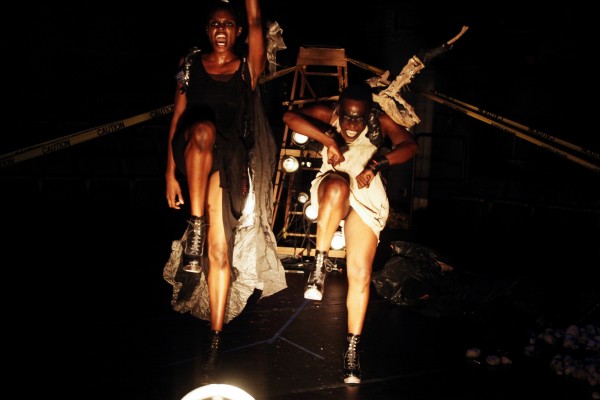
Chipaumire erupts in a series of shrieks, grunts, and screams, heightening the sense of claustrophobia. Sometimes her groans sound sensual, at others, frightening, as if she were in the midst of being exorcised. She hunches over, body close to the ground, shoulder blades squeezed together, her elbows like knives pointing towards the ceiling.
—–
Together, Chipaumire, along with Okpokwasili, confront stereotypes of the black, African female body as other, as colonized object, as that which is looked at and analyzed.
Born in Mutare, Zimbabwe and currently residing in Brooklyn, Chipaumire looks to Miriam Makeba, both the South African figure and the name itself, as a source of inspiration. She writes:
My Miriam is disobedient, obstinate, rebellious, and beloved…Miriam is a name carried by the mother of Jesus, the sister of Aaron and Moses, as well as the iconic singer and political activist Miriam Makeba.
A sense of counter myth making pervades the black box theater.
—–
In her book, Queering the Color Line (2004), scholar Siobhan B. Somerville writes:
The racial difference of the African body, implied Flower and Murie [in “Account of a Dissection of a Bushwoman” (1867)], was located in its literal excess, a specifically sexual excess that placed her body outside the boundaries of the ‘normal’ female.
Excess pulsates through Chipaumire and Okpokwasili’s gyrating bodies and fierce ululations.
Excess empowers them.
Excess stares back at us.
—–
Omer Sosa’s live score induces an auditory hallucinogenic effect throughout the performance. They include voices, fast-paced drumbeats, a sample of Glen Gould performing Bach’s “Goldberg Variations,” to name a few.
Sound contributes to Miriam’s excess.
Sound contributes to chaos.
—–

Each time she crosses in truth or fiction, she breaks the tracery of delicate glass threads that marks the border. A border is felt in the body as fear and sometimes…no, I cannot speak for her now.
Bhanu Kapil
Humanimal: A Project for Future Children
—–
The most powerful performances are the ones that I have the most difficulty putting into words.
Words are a source of light. They introduce a perspective from which to see. Without them there is only memory.
Dear Miriam,
Memory is a dark place.
—–
all photos by Julieta Cervantes, courtesy of BAM
]]>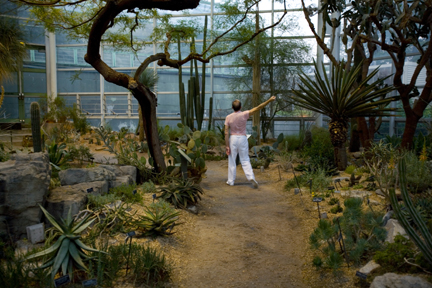
courtesy of Elsie Management.
A dance evolves within me over time. What isn’t memorable eventually slips away, while other moments may become more vivid. An entire scene can be condensed into a single image. I’ve always felt this with performance, but never have I experienced this evolution so intensely, as I did after seeing Paradis by Yanira Castro | a canary torsi. Set in the lush Brooklyn Botanic Garden, Castro’s Paradis guides the audience through a collective journey from purgatory to heaven, or to her conception of paradise.
It is a little after 8pm. We begin at the Garden’s old visitor center, and are led past a beautiful assortment of lily pads in a rectangular pond to the Desert Pavilion. One by one, we surround the octagonal greenhouse. Cacti, succulents, and other arid plants frame a lone figure, dressed in a white blazer, pants, and tennis shoes, Peter Schmitz. He stands motionless for some time and then begins to walk, slowly and curiously, on the Pavilion’s ovular path. His body stutters and sways as if coming to life for the first time — a lost man in purgatory, a delusional god waiting for a storm, Frankenstein’s monster. He walks around hesitantly, stretching his arms out like a bird, picking up his pace and then slowing down again.
Several guides with walkie talkies stand around us, occasionally walking around. A tinny improvisational piano tune emerges from the static, providing a peculiar soundtrack.
Schmitz’s performance has a silent film quality, like a mime’s portrayal of a mad scientist. A clawed hand, which simulates holding an apple, comes at his face uncontrollably. A maniacal scream escapes from the Pavilion.
It’s an astonishing and memorable sight, but one that relies heavily on the finely textured, cacti landscape. This could be an argument for the dance’s site-specific nature, but Schmitz’s movement is very literal, preventing our imaginations from wandering freely away from the narrative in front of us. After about thirty minutes Schmitz takes off his blazer and hunches over as if entering a self-made cocoon.
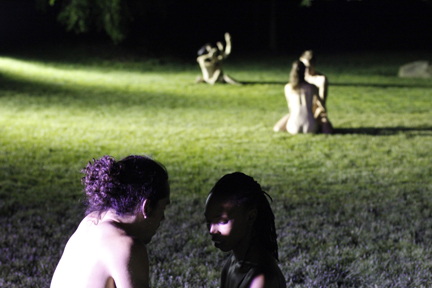
courtesy of Elsie Management.
Patience is required in purgatory.
We are led slowly past an expansive grassy lawn with the scattering lights of fireflies. Eight dancers — Peggy H. Cheng, Daniel Clifton, Simon Courchel, Shayla-Vie Jenkins, Luke Miller, Pamela Vail, Darrin Wright, and Kimberly Young — dressed in white summery attires stand in the far distance. Occasionally one dancer darts behind the others, sprinting ahead into the distance. As we walk, they disappear and reappear like ghostly apparitions. The scene unfolds with cinematic ease.
Uncertainty, ungraspable, fleeting…
Is this paradise?
We arrive at the Garden’s Cherry Esplanade to Michael Daupinais playing a piano, the source of music from the walkie talkies. We linger around while watching him play, unsure as to what comes next until we see the dancers at the far end of the lawn. As twilight fades into darkness, they come towards us taking long leap-like strides, while four large spotlights situated behind us gradually intensify. It is one of the most arresting moments I have ever experienced in a performance.
Eventually we are approached by one of the dancers and broken up into smaller groups. “Watch only me.” Jenkins says to my group. The effect is strangely seductive. Never have I had these words said to me during a performance. Never have I been so inclined to obey. The piece closes with a group of four intimate and sensual duets performed simultaneously by the eight dancers in flesh-colored leotards and a brief sing-a-long with Daupinais.
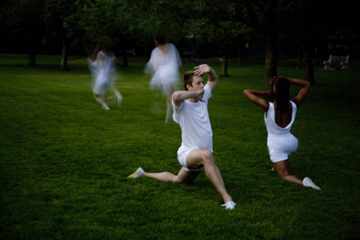
courtesy of Elsie Management.
Exiting the now dark landscape through a path lit by flashlights exemplified many of the problems with the piece. Often Paradis is overwhelmed by the scenery — an idyllic garden at dusk and the muggy summer air — all of which I am experiencing for the first time. Although Castro’s choreography accentuated the characteristics of the Garden, it didn’t deepen or challenge my perception of the space leading to feelings of restlessness and boredom.
What is boredom if not the body’s inability to access an experience? Or, the inability to retain it?
But several images have followed me:
cocooned man
cacti terrain
ghosts by a piano
bodies come toward me
if not hesitantly
watch
and I will obey
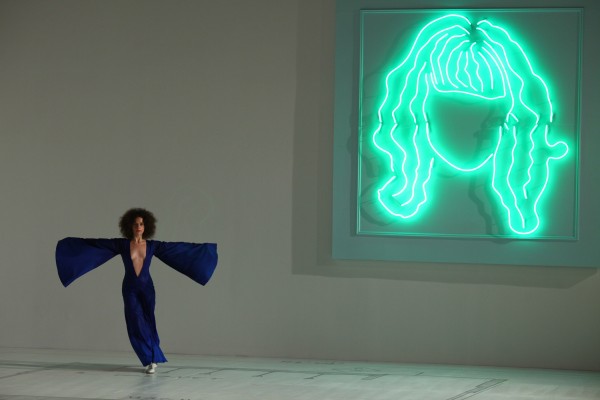
Sarah Michelson's "Devotion Study #1—The American Dancer," © Paula Court.
The observation of devotion could finish you…
–Erín Moure, Pillage Laud
The act of going to performances occupies a bit of an obsessive and irrational space in my life. I liken it to ritual tied in with a sense of yearning and loneliness. There are feelings of uncertainty. Thus, when British choreographer, Sarah Michelson says: “People need faith. You can’t argue if faith exists. It’s here,” near the end of the Devotion Study #1 – The American Dancer, it resonates with me. I succumb.
——
The title of Michelson’s performance is accompanied with a long quote from George Balanchine:
Superficial Europeans are accustomed to say that American artists have no “soul.” This is wrong. America has its own spirit — cold, crystalline, luminous, hard as light…Good American dancers can express clean emotion in a manner that might almost be termed angelic. By angelic I mean the quality supposedly enjoyed by the angels, who, when they relate a tragic situation, do not themselves suffer.
——
A blueprint of The Whitney Museum of American Art is painted in gray on the white gallery floor. Michelson’s presence haunts us in the form of a neon-green, light drawing — a faceless portrait. The portrait is reflected in the polygonal window that juts out of the building on the opposite gallery wall. Audience members sit along both sides of the elevator entrance. We wait to the sound of a metronome rising from the speakers on the gallery floor. A dense, cluster of lights hangs from the center of the ceiling like a mechanical sun. The space is vast and the feeling is empty.
Nicole Mannarino enters stage right, hair teased out into an Afro. She is wearing white jazz shoes and a deep blue (think Yves Klein) body suit with a deep V cut down to the center of her torso. The sleeves and pant legs flare out at the ends like budding wings.
She begins taking quick and spritely steps backwards, forming small circles over the blueprint. The circles grow larger and then shrink again. She pauses at the back corner.
America has its own spirit.
It is faceless.
——
Whitney Biennial co-curator, Jay Sanders, and Michelson sit amongst the audience, and read a text written for the performance by playwright Richard Maxwell. Their dialogue (Sanders reads for Maxwell) touches upon the existential afterthoughts of “life after Devotion ” which premiered at The Kitchen in January 2011. The text is replete with narcissism and references to porn and drugs, a bit of a macho, mocking undertone especially when spoken over Mannarino’s physically intense and repetitive movement.
Mannarino exits and then reenters. The conversation replays itself.
——

Sarah Michelson "Devotion Study #1—The American Dancer," © Paula Court.
Eleanor Hullihan in a short, olive-green dress with similar flared sleeves joins Mannarino in her tiring task. They circle together, backwards, faster and faster. Sweat stains start to form on Mannarino’s back.
I dip in and out
The maniacal ordinary
The wet sweat
——
Richard Maxwell: The world has come to an end.
Sarah Michelson: You seem to get so trapped by your own thoughts.
Richard Maxwell: I want to learn. I do.
——
The backwards circles continue, mercilessly. Hullihan and Mannarino have their arms out like airplane wings, like angels. Occasionally they tilt to the left or go on tiptoes. Hullihan unexpectedly breaks away from Mannarino.
——
A Klee painting name “Angelus Novus” shows an angel looking as though he is about to move away from something he is fixedly contemplating. His eyes are staring, his mouth is open, his wings are spread. This is how one pictures the angel of history. His face is turned toward the past. Where we perceive a chain of events, he sees one single catastrophe which keeps piling wreckage upon wreckage and hurls it in front of his feet.
–Walter Benjamin, “Theses on the Philosophy of History”
It should be an independent and self- relying unit, exposed to history…
–Marcel Breuer, architect statement for The Whitney Museum, 1964
——
There is cruelty in the repetition, and exhaustion within time. There is a ticking metronome accompanied with a persistent, minimalist soundtrack — a lone drone chord, with nearly imperceptible variations. Is the sound alone enough to drive you mad? Are the metronome and the dancers’ steps speeding up? Is there an opportunity for transcendence? What does it mean to create a dance that almost only involves moving backwards in circles for 90 minutes? What does Devotion Study #1 – The American Dancer have to do with the history of The Whitney building? What does it mean for a space to be “exposed to history”? What does it mean for a dance? Is this a dance about the history of dance? Are they angels of history? Patterns emerge as they try over and over again, rapidly swirling around. Endlessly.
I wish I could come up with answers — meanings. I wish I could make obvious connections, but I can’t. The dancers elude it; it’s their Sisyphean fate.
——
Maggie Cloud joins the two women in a tight-fitting white, long-sleeved leotard; followed by a shirtless James Tyson in effeminate, black bell-bottom pants. Mannirino’s uniform is soaked with sweat, forming a deep V on the back of her uniform. She wears the same blank face. You cannot see her pain, but only imagine it. She becomes increasingly difficult to watch. A dark angel. A clean emotion.
——
A circle is a necessity. Otherwise you would see no one. We each have our circle. How old is America. Very old.
— Gertrude Stein, A Circular Play: A Play in Circles
——
Moriah Evans enters in a gray, shapeless over-sized shirt. They are beautiful as a group, a flock of flying bodies. Evans performs circles alone stage right, while the four other dancers circle backwards stage left.
She is separated from the others throughout her brief time on stage. We feel her lonely frustration. Faith is a cruel beast.
Punishment is moving backwards in time.
Wide, wide circles.
——
If we concentrate our attention on trying to solve a problem of geometry, and if at the end of an hour we are no nearer to doing so than at the beginning, we have nevertheless been making progress each minute of that hour in another more mysterious dimension. Without our knowing or feeling it, this apparently barren effort has brought more light into the soul.
–Simone Weil, Waiting for God
——
The air is heavy with impatience, but you must wait.
What is progress for Michelson? Is it in repetition? Perception?
I start to notice the little details: the drawing of Michelson’s face on the white, circular patches on their shoes; as if she were God, controlling every step.
——-
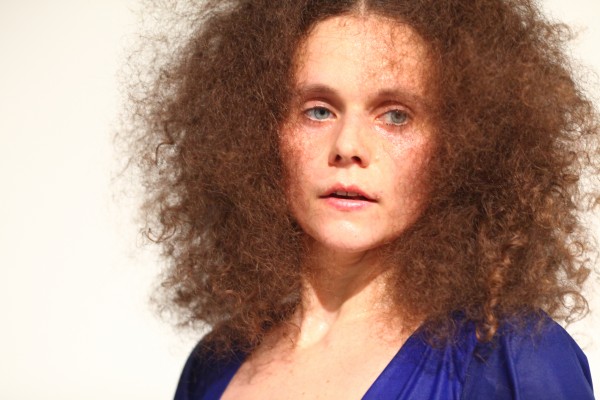
Sarah Michelson Devotion Study #1—The American Dancer, © Paula Court.
At what seems to be the climax of the performance, all the dancers (except Evans, who continues to circle by herself before swiftly exiting) take a stance along the back wall while the cluster of lights grows steadily brighter. Their shadows, triple, quadruple, quintuple, on the white wall beneath the glowing sun. Kira Alker in a brown body suit and horse head makes a brief appearance. She accompanies the five figures as they alternate their supporting leg for several, long minutes.
I don’t know what I look for when I go to a performance. I don’t know what I’m after. I am alleviated…hard as light.
——
Circles again.
Over and over and over and over.
Cloud and Tyson exit.
——
She can admire me. She can always admire me. Do not try circles exclusively.
–Gertrude Stein, A Circular Play: A Play in Circles
——
Hullihan stops and takes a series of stunted leaps forward in small circles.
Repetition can be likened to play.
A meditation on dance and faith.
The untidiness of intention.
The grueling nature of doubt.
——
Sarah Michelson: There’s insignificance in significance.
]]>